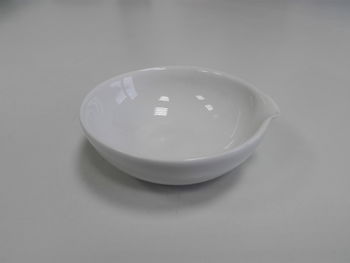Difference between revisions of "Evaporating dish"
(Created page with "{{Stub}} An evaporating dish glazed on the inside. An '''evaporating dish''' or '''evaporating basin''' (sometimes r...") |
|||
| (7 intermediate revisions by the same user not shown) | |||
| Line 2: | Line 2: | ||
[[File:Evaporating dish glazed porcelain.jpg|thumb|350px|An evaporating dish glazed on the inside.]] | [[File:Evaporating dish glazed porcelain.jpg|thumb|350px|An evaporating dish glazed on the inside.]] | ||
An '''evaporating dish''' or '''evaporating basin''' (sometimes referred to as '''[[watch glass]]''') is a laboratory item used for the evaporation of solutions and supernatant liquids, and sometimes to their melting point. | An '''evaporating dish''' or '''evaporating basin''' (sometimes referred to as '''[[watch glass]]''') is a laboratory item used for the evaporation of solutions and supernatant liquids, and sometimes to their melting point. | ||
| + | |||
| + | Evaporating dishes are used to evaporate excess solvents, most commonly water, to produce a concentrated solution or a solid precipitate of the dissolved substance. | ||
==General== | ==General== | ||
| − | Evaporating dishes have the appearance of a thin concave dish with a beak. The most common type is made of glazed fired porcelain, though all-glass versions exist. Plastic | + | Evaporating dishes have the appearance of a thin concave dish with a beak, though some models may have flat bottom. The most common type is made of glazed fired porcelain, though all-glass versions exist. Plastic evaporating dishes are rarely encountered or used, as repeated heating will deform or wear them. |
==Availability== | ==Availability== | ||
Evaporating dishes can be bought from lab suppliers or online. | Evaporating dishes can be bought from lab suppliers or online. | ||
| + | |||
| + | Alternatively, you can use glazed porcelain dishes, though you may not reuse them for food after being exposed to lab reagents or contaminated suspensions/solutions. Glass dishes or cups may also be used. | ||
==Projects== | ==Projects== | ||
*Evaporate solutions | *Evaporate solutions | ||
*Recrystallize compounds | *Recrystallize compounds | ||
| + | |||
| + | ==Handling== | ||
| + | The glazing covering the inside of the dish resists the attack of many acids, but will be attacked by alkali at high temperatures. | ||
==See also== | ==See also== | ||
| + | *[[Crystallizing dish]] | ||
*[[Crucible]] | *[[Crucible]] | ||
*[[Watch glass]] | *[[Watch glass]] | ||
| Line 20: | Line 28: | ||
<references/> | <references/> | ||
===Relevant Sciencemadness threads=== | ===Relevant Sciencemadness threads=== | ||
| + | *[http://www.sciencemadness.org/talk/viewthread.php?tid=82540 Round vs flat bottom evaporating dish] | ||
*[http://www.sciencemadness.org/talk/viewthread.php?tid=70450 Porcelain is cracking annoying] | *[http://www.sciencemadness.org/talk/viewthread.php?tid=70450 Porcelain is cracking annoying] | ||
| + | *[http://www.sciencemadness.org/talk/viewthread.php?tid=81754 Deep Joy] | ||
[[Category:Lab equipment]] | [[Category:Lab equipment]] | ||
[[Category:Ceramicware]] | [[Category:Ceramicware]] | ||
[[Category:Glassware]] | [[Category:Glassware]] | ||
Latest revision as of 22:45, 24 January 2019
 |
This article is a stub. Please help Sciencemadness Wiki by expanding it, adding pictures, and improving existing text.
|
An evaporating dish or evaporating basin (sometimes referred to as watch glass) is a laboratory item used for the evaporation of solutions and supernatant liquids, and sometimes to their melting point.
Evaporating dishes are used to evaporate excess solvents, most commonly water, to produce a concentrated solution or a solid precipitate of the dissolved substance.
Contents
General
Evaporating dishes have the appearance of a thin concave dish with a beak, though some models may have flat bottom. The most common type is made of glazed fired porcelain, though all-glass versions exist. Plastic evaporating dishes are rarely encountered or used, as repeated heating will deform or wear them.
Availability
Evaporating dishes can be bought from lab suppliers or online.
Alternatively, you can use glazed porcelain dishes, though you may not reuse them for food after being exposed to lab reagents or contaminated suspensions/solutions. Glass dishes or cups may also be used.
Projects
- Evaporate solutions
- Recrystallize compounds
Handling
The glazing covering the inside of the dish resists the attack of many acids, but will be attacked by alkali at high temperatures.
